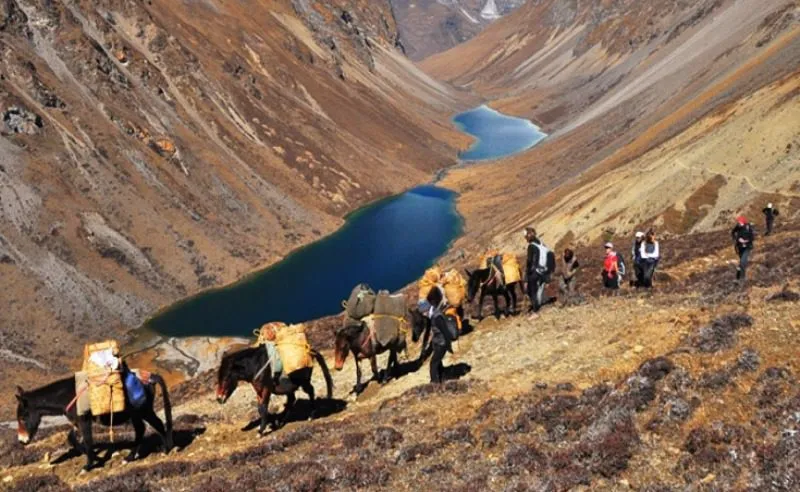
Bhutan Packing List
This list is only a guideline, and it will vary a little according to the season, where you will be trekking, and the duration of the trek. Usually, the Himalayan weather is chilly in the morning & night with daytime sunshine. So, please pack along warm and cool clothing. The weight limit for your luggage is 15 kg (33 pounds) carried by your porter, but you are also required to carry your daypack (of your necessary things) on your own.
Important documents and items
- Valid passport, 2 extra passport-size photos, airline tickets
- Separate photocopies of passport, Proof of insurance
- Dollars, pounds, or Euros in cash for purchasing a Bhutanese visa at Paro airport, for paying for restaurants and hotels, for gratuities and snacks, and for purchasing your own drinks and gifts
- Credit cards, Bank/ATM/Cash machine cards for withdrawing funds from cash machines (bring a photocopy of your cards), traveler’s checks, etc.
Clothing
- Lightweight thermal tops
- Fleece jacket or pullover
- Fleece Wind-Stopper jacket (optional)
- Waterproof shell jacket (preferably breathable fabric)
- Lightweight thermal gloves
- Underwear (4)
- Shorts (2)
- Lightweight cotton long trousers/pants
- Lightweight thermal bottoms
- Sun hat or scarf
- Warm fleece hat or light balaclava
- T-shirts (2)
- Thin, lightweight (inner socks) (4)
- Sunglasses with UV protection
- Headlamp (e.g., Petzl), spare bulbs & batteries
- A small padlock to lock the trek bag
- Plastic bags—for keeping items dry inside the trek bag
- Daypack (35-40 liters/2500-3000 cubic inches)
- Water bottles (2)
- Toiletries
- Small wash towel
- Footwear appropriate to the trip
- Waterproof shell trousers/pants (preferably breathable fabric)
Additional packing list for trekking:
Footwear
- Hiking boots: Good ankle support.
- Hiking shoe or sneaker: As an extra, or to use in Paro.
- Sandals: Slip-on sandals or flip-flops will give your feet a breather during the evening.
- Woolen socks: 3 pairs of heavy woolen hiking socks (75-86% wool).
- Light socks: 3 pairs of light woolen socks (at least 50% wool).
Outerwear
- Tri-climate jacket: The Himalayan environment is windy during evenings, and it rains sometimes.
- It gets windy in the Himalayan range during evenings, and sometimes it rains. Early morning, this jacket can be layered up with your down or fleece jacket.
- Down jacket: Light and warm, and at least 700-fill goose down insulation for lightweight warmth. It gets colder at night and in the early morning.
- Fleece jacket: Your fleece can be layered with your triclimate or down jackets.
Clothing
- Hats: A warm one for the morning and a baseball cap or sun hat for the afternoon.
- Gloves: Insulated gloves for warm hands during the cold mornings and liner gloves for cool temperatures in the evening
- Hiking pants: 2 pairs of hiking pants, one convertible (it can get hot in the afternoon).
- Cargo Pants: 1 pair of jeans and 1 pair of cargo pants for in Paro, and either fleece or other heavy sweatpants to wear during the evening downtime.
- Long underwear tops: At least 3—to wear as a base layer for warmth.
- Underwear: 7 pairs of underwear.
- Tee and Tank: 5 performance tees or tanks to layer with the long underwear tops.
- Long underwear bottoms: 2 mid-weight long underwear bottoms to layer with your hiking pants during cooler points of the trek, or to provide extra comfort under your fleece pants in the evenings.
Gears
- Day backpack: 25-35 L backpack (depending on one’s preferences) to comfortably carry your camera, water bottle, extra clothes, and snacks during your daily trek. In most cases, porters usually start early in the morning and reach the desired destinations with greater speed. You won’t see them until later in the evening at the trek-end point.
- Duffle bag XL: Provided by us to be returned after the trek.
- Small lock: Bring a small lock for your duffel bag.
- Trekking Poles: Provided by us to be returned after the trek.
- Sleeping bags: -10° C / 14° F for a teahouse (rustic lodging) and -20° C / -4° F or warmer for camping treks.Guesthouses on your trekking route will only provide you with blankets. Though provided by us to be returned after the trek.
- Trekking Towels: 1 large, 1 medium, and a few washcloths (quick dry is a plus!).
Accessories
- Cameras, batteries, and memory cards:Bring extra batteries. 32 GB of memory should be sufficient.
- Sunglasses: Make sure they have 100% UV protection.
- Headlamp: Use during the early morning portions of the trek to light your way.
- Tablet computer: For entertainment in the evening; there isn’t much to do after 4 pm, and it is also quite cold and windy in the higher altitudes. Many trekkers choose to stay in their rooms at night. You should also bring along books, MP3 players/iPods, or playing cards to pass the time. These will become your best friends if you ever get stranded at the airport.
- Trail map/guidebook
- 1 modest swimsuit
- Binoculars (optional)
- Voltage converter (from 220 to 110)
- Plug adapter (2 round pegs to 2 flat pegs)
Medical
- Small, personal first-aid kit (simple and light)
- Aspirin, first-aid tape, and plasters (Band-Aids)
- 1 skin-blister repair kit
- Anti-diarrhea pills
- Anti-headache pills
- Cough and/or cold medicine
- Anti-altitude sickness pills: Diamox or Acetylzolamide
- Stomach antibiotic: Ciprofloxacin, etc. Do not bring sleeping pills, as they are a respiratory depressant.
- Water purification tablets or a water filter
- 1 set of earplugs
- An extra pair of prescription glasses and contact lens supplies.
